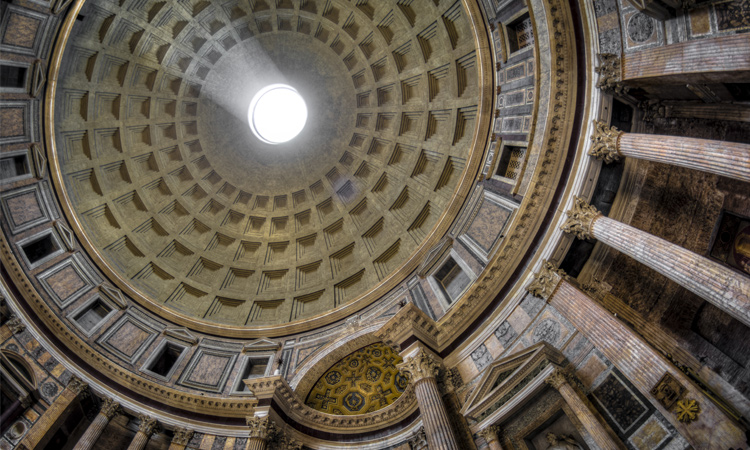 [Getty Images]
[Getty Images]
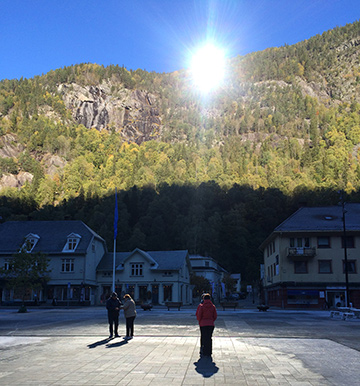 The citizens of Rjukan, Norway—in shadow for much of the year—installed solar-powered, rotating mountain-top mirrors to capture sunlight and redirect it into the town. [Karin Rø/visitRjukan]
The citizens of Rjukan, Norway—in shadow for much of the year—installed solar-powered, rotating mountain-top mirrors to capture sunlight and redirect it into the town. [Karin Rø/visitRjukan]
Since the first dawn, humans have counted on the sun for everything from light and heat to the demarcation of time to religious inspiration. The broad spectrum of radiant energy from the sun, stretching from the ultraviolet to the near-infrared, shines on Earth’s surface as a collimated source that can be concentrated and directed. So dependent are we on sunlight that, when deprived of it, our physical and mental health can suffer (as, for example, from a deficiency in vitamin D, which is created in our bodies through exposure to the sun’s ultraviolet rays).
Modern life, however, requires many of us to spend more than 80 percent of our time indoors, separating us from the benefits of natural lighting. Various artificial-lighting strategies can work to emulate the benefits of the solar spectrum. Yet, repeatedly, studies have pointed to the unique strengths of natural lighting for increasing happiness, color perception, productivity and performance.
“The history of architecture is the history of the struggle for light” —Le Corbusier
An obvious solution is to use the light that’s already falling into our laps. “Daylighting” consists of strategies to tap the sun’s natural light to provide illumination, particularly in building interiors. In architecture, daylighting—which leverages fundamental optical principles—has the potential to not only increase happiness and productivity, but also to heighten energy efficiency; according to a review in Energy Research Journal, using natural lighting over electrical solutions can reduce a building’s electricity consumption by 15 to 60 percent.
The judicious use of daylighting can also boost a space’s aesthetic appeal. The celebrated modern architect Le Corbusier may have put it best: “The history of architecture,” he wrote, “is the history of the struggle for light.” Here’s a look at some ways optics is helping in that effort.
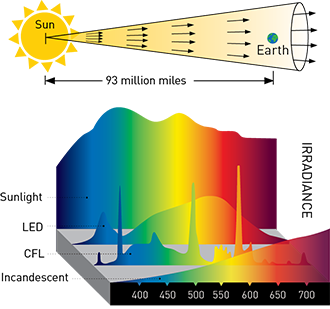 Solar basics
Solar basics
Top: Because of the sun’s distance from Earth, the light it delivers is collimated as it reaches the surface, which allows for it to be directed using optical elements such as mirrors and lenses. Bottom: A broadband light source, the sun’s emissions have peak output in the visible wavelengths (390–745 nm) and form the human reference point for “true color.” Other light sources have attempted, with varying success, to mimic that distribution. [Typozon / Popular Mechanics]
Daylighting’s challenges … and solutions
The aim of daylighting in modern buildings is to increase natural light in building interiors with consideration for uniformity, directionality and glare. This becomes a nontrivial design challenge given sunlight’s dynamic nature. Daylighting strategies must manage changing intensity, direction and spectral properties across seasonal, daily and meteorological variations.
Some elegant solutions to these challenges have employed a fundamental understanding of light, its properties and its complex phenomena of propagation and interaction with matter to overcome traditional limitations. When applied and combined in creative ways, light’s fundamental propagation behaviors—reflection, refraction and scattering—can provide both functionality and form in daylighting.
Sometimes these techniques focus particularly on aesthetic effects. Scattering and refraction, for example, can be used to split or filter the solar spectrum, producing rainbow colors. The directionality and time-dependence of sunlight can provide a building’s design with accent-lighting strategies that can aesthetically leverage solar light’s dynamic nature. Such techniques have been successfully used throughout history, from Stonehenge to Egyptian temples and the Pantheon to modern museums and public spaces.
But daylighting is about more than aesthetics. In the sections that follow, we look at some of the main architectural and optical elements that have been used to bring the sun inside for warmth and light as well as beauty.
Daylighting then & now
Here are some examples of daylighting from antiquity to the present
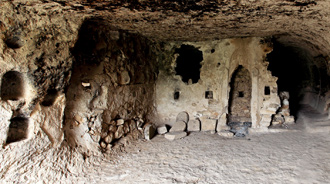 Hasankeyf, Turkey, 2000 B.C.E.
Hasankeyf, Turkey, 2000 B.C.E.
Early cave dwellings included openings to control light and air. Over time these were covered with thin slabs of marble, mica or piled paper—early versions of the large glass panes that we know today.
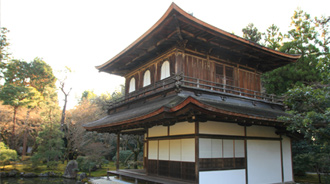 Kyoto, Japan, 17th century
Kyoto, Japan, 17th century
Strategies such as light reflection from surroundings, sun-controlling overhangs and diffuse internal elements allowed buildings to be designed with new beauty and functionality.
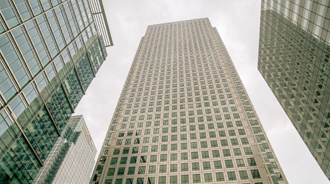 London, U.K., 20th Century
London, U.K., 20th Century
Industrialization allowed for windows to wrap around the whole building envelope, but the growth of the workplace required more than daylighting to illuminate commercial buildings. By the late 20th century, however, concerns about energy usage gave daylighting a new lease on life.
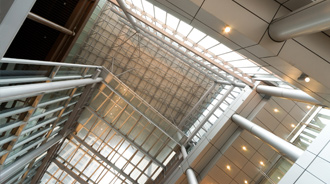 Taipei, Taiwan, present day
Taipei, Taiwan, present day
Efforts to reduce energy usage and environmental footprint of today’s buildings draw on sunlight, via structures such as light guides, to maximize energy performance and occupant comfort.
[“Daylighting then & now” images: Getty Images]
Windows
Fenestration-based daylighting—lighting through windows—is, of course, the oldest and simplest form of natural interior lighting. The basic single-pane windows that dominated the last millennium, however, can no longer meet the energy and comfort requirements of modern buildings, and maximizing performance in those areas constitutes the key focus of modern window engineering and design.
Such designs must consider many factors: visual performance, thermal comfort and energy loss, and shading and light control. Glazing systems to address those factors, in ways highly specific to building location, climate and occupancy needs, are now being designed with a precision that surpasses past practices, by combining one or more of several elements:
Metallic coatings on glass or polymer surface can control which wavelengths of the solar spectrum are allowed into a building—for example, by transmitting visible light while blocking infrared light, to reduce solar heating. These coatings can also manage the intensity and color of incoming light for functionality or aesthetics.
Diffusive coatings use scattering media or surface textures to change collimated light into a more uniform source, while also reducing glare. These coatings blur or opacify the image through the window, and can be used as a privacy element in the building envelope.
Angularly selective fenestration can limit natural light to certain locations or times based on the angle of incoming light. These panes can be translucent or opaque at particular angles of incidence by using small patterns on the surface of the window glass or by embedding small prismatic materials in the glass itself.
“Smart” windows can change their light transmission properties based on an external trigger such as light (photochromic windows), heat (thermochromic windows) or voltage (electrochromic windows). These windows have the advantages of providing passive or active control of daylighting for light, heat and comfort control. (For more on smart windows, see “A Smart View of the Future.”)
Other aspects of window design, such as multiple panes and low-conductivity gases, enable windows to be more insulating or soundproof, making daylighting more practical and attractive for architects and occupants alike. Additionally, external elements, such as sun shades that block light from entering a building at unfavorable angles, can provide additional control for windows.
Many software packages exist to help architects and building owners simulate daylighting conditions to select the right combination of these elements. Design tools such as Sefaira, Rhino, FLUCSDL and AGi32 allow architects to optimize and iterate with design elements in new and innovative ways before ground is ever broken on a new building.
Beyond windows: Light collection, transport and distribution
Buildings with large interior spaces or limited access to sunlight can use collection systems to harvest natural light, and other systems to transport or concentrate that light into specific areas.
Designing for daylight
Architects consider many factors—occupant needs, location, climate and much more—for effective daylighting. Here are a few design tips.
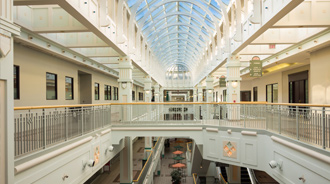 Orientation
Orientation
Design tip: Think about where the sun rises and sets throughout the year, how sunlight changes during the day, and the best balance to strike. If you’re in the northern hemisphere, elongate your building east to west to avoid summer heating while maximizing daylight.
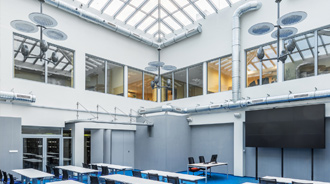 Location
Location
Design tip: Consider which parts of the building have direct access to sunlight, and how to incorporate daylighting without compromising room function. Bring daylight in high with windows. Put occupied spaces with light needs in daylight zones.
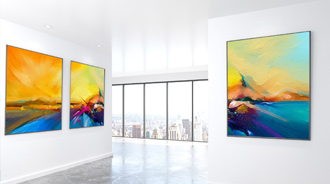 Color
Color
Design tip: Assess design needs and opportunities to use color—and restrictions imposed by UV-sensitive material and artificial lighting. Use light-colored interiors to maximize light penetration and uniformity, and bring in daylight from many sources and directions.
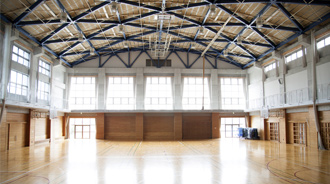 Heat and comfort
Heat and comfort
Design tip: Think about how daylighting will affect air-conditioning and heating requirements, taking account of seasonal variations. Provide active or passive control using additions or techniques such as blinds, sun shades and diffuse surfaces.
[“Designing for daylight” images: Getty Images]
Collection
Passive light collection uses an optical collection system of fixed position and orientation. Such passive systems often use one or more light reflections by mirrors and refraction by lenses to optimize, distribute or increase light collection. Such a system typically needs to be designed with consideration for the year-round variation in shadows, solar angles and daylight duration. As a result, these static collection systems often require large components to reach needed performance specs—but they can provide a relatively simple, low-cost strategy to harvest sunlight.
An active collection system, in contrast, tracks the orientation of incoming sunlight continuously or semi-continuously throughout the day and year. Tracking mechanics can be simple one-axis motion (such as a Fresnel lens that follows daily solar angle variations) or two-axis motion (such as a heliostat system that uses a mirror to reflect sunlight as it varies daily and seasonally). Active collectors are more efficient than passive systems, but they add complexity and costs to systems and require additional maintenance.
Transport
However sunlight is collected, it needs to be taken where it’s most useful. Light guides for this directed transmission can use any combination of reflection, refraction or deflection to transport sunlight from the building envelope to interior areas. By combining light guides with other elements, systems can be created to transport direct or diffuse light to virtually any location within a building. For example, plain mirrors can reflect light from the roof of a building down through a reflective funnel into interior rooms, where a diffuser can spread the light uniformly to otherwise dark regions.
These transport systems use a variety of materials and strategies to match the needs of a particular application. Highly reflective mirrors are common, but by varying the material used or surface condition, the light’s emission and color can be varied. Prismatic materials or optical fibers use total internal reflection to transport light in a small, flexible form that enables easier integration into buildings. Convergence lenses made of transparent materials can use consecutive divergence and convergence of focal points to transport a concentrated beam with minimal structural material.
Distribution
Light distributors extract light from an incoming source and emit it in a desired form. This incoming source could be direct natural light, concentrated light being transported through a guide, or a combination of sources. In many applications, light is emitted diffusely to reduce non-uniformities in the room illumination pattern, “hot spots” and glare. Common strategies for uniform distribution include prismatic elements or scattering materials.
Systems: Putting it all together
By combining the elements of collection, transportation and distribution, daylighting systems can reach new levels of performance and control. They can increase internal light comfort by reducing non-uniformities and glare, can cut energy costs by optimizing light and heating, and can boost occupant happiness and productivity—shown to be the largest cost benefit of natural light. These systems can also use control elements and electric-light integration to balance lighting and heating loads for a diverse set of operation conditions.
When well-designed with other elements of the building, these systems can provide a custom solution to satisfy both occupant needs and energy efficiency. One intriguing example of such an integrated solution, combining daylighting and solar art, was designed by Peter Erskine for a municipal facility in California (see “Daylighting meets art” below).
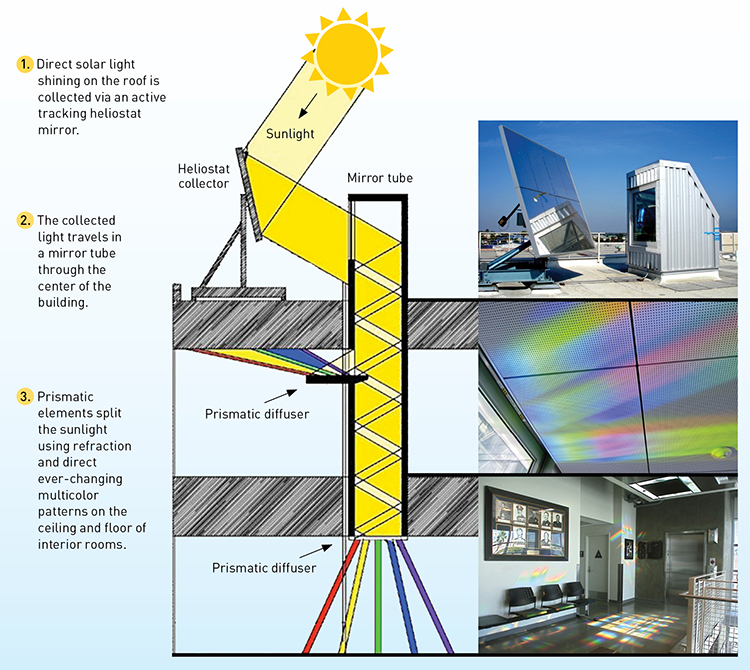 Daylighting meets art: Erskine solar project
Daylighting meets art: Erskine solar project
The Solar Spectrum Environmental Artist Peter Erskine created a daylighting system for the Los Angeles Police Department, Valley Traffic Division, Calif., USA, that marries shrewd light guiding with an aesthetic approach to interior light. [Artwork and photography copyright by Peter Erskine, www.erskinesolarart.net]
Daylighting’s future
The world’s growing population will spur an ever-increasing need for bigger, better, more affordable and energy-efficient buildings. For daylighting, that means finding the best way to use every photon at its highest potential.
The next generation of daylighting systems will rely on material innovations and advancements. The universal truth for buildings is that no two are exactly the same or have identical needs. Architects and engineers need a diverse set of affordable materials to achieve the optimum solutions, especially as our needs change and grow with time.
Current advances include transparent insulating materials (TIMs), such as porous films or aerogels, that overcome the thermal limitations that make large windows impractical in many climates. Other material developments include creating transparent or translucent photovoltaic cells that can harvest unused solar energy outside the visible spectrum. Additionally, many of the materials and elements currently being used in daylighting, such as reflectors, prisms and collectors, are continually being improved to increase performance through careful study and optimization of structures and material properties.
By combining advances in materials, controls and design, daylighting will continue to press our understanding of sunlight and optics into service to optimize indoor experiences.
The future of daylighting will also rely on advances in automation and control. Automated controls can potentially cut energy needs considerably. Adaptive controls have the ability to reduce or eliminate varying non-idealities that cause issues for occupants or processes. Instantaneous control allows for people to create, in a given space, the best environment for their productivity and comfort. Systems that use one or more of these approaches are becoming increasingly prevalent, and will soon be an essential part of daylighting in new construction.
Many daylighting elements already serve multiple purposes, such as systems that combine thermal management with aesthetics. Future systems will include even more multi-functionality; as the limits of versatility and design are expanded, the same elements that provide natural light can also address issues such as energy collection and acoustic control.
By combining advances in materials, controls and overall design, daylighting will continue to press a fundamental understanding of sunlight and optics into service to optimize our indoor experiences. From windows to skylights to light pipes, the right use of daylighting design can bring comfort and happiness into our ever-increasing indoor experiences. Even as Earth continues to revolve around the sun, so our daily lives will continue to revolve around sunlight—as they have since the beginning.
Elise M. Strobach and Svetlana V. Boriskina are with the Massachusetts Institute of Technology, Cambridge, Mass., USA.
References and Resources
-
F. Moore. Concepts and Practice of Architectural Daylighting, Van Nostrand Reinhold (1985).
-
M. Guzowski. Daylighting for Sustainable Design, McGraw-Hill (1999).
-
N. Ruck et al. Daylight in Buildings: A Source Book on Daylighting Systems and Components, Report No. LBNL-47493, Lawrence Berkeley National Laboratory (2000).
-
G.D. Ander. Daylighting Performance and Design, 2nd ed., Wiley (2003).
-
R.P. Leslie. “Capturing the daylight dividend in buildings: Why and how?,” Build. Environ. 38, 381 (2003).
-
D. Phillips. Daylighting: Natural Light in Architecture, Routledge (2012).
-
S. Rockcastle and M. Andersen. Annual Dynamics of Daylight Variability and Contrast, Springer (2013).
-
M.G. Nair et al. “Classification of indoor daylight enhancement systems,” Light Res. Technol. 46, 245 (2014).
-
A. Yacoubian. Optics Essentials: An Interdisciplinary Guide, CRC Press (2014).
-
M.-C. Dubois et al. Energy Res. J. 6, 25 (2015).
-
M. Konstantoglou and A. Tsangrassoulis. “Dynamic operation of daylighting and shading systems: A literature review,” Renew. Sustain. Energy Rev. 60, 268 (2016).
